Impact of a Cold Environment on the Performance of Professional Cyclists: A Pilot Study
Abstract
1. Introduction
2. Materials and Methods
2.1. Participants
2.2. Study Design (Procedure)
2.3. Equipment and Measurements
2.4. Statistical Analysis
3. Results
3.1. Normalized Ambient Temperature (Tawc)
3.2. Core Temperature (Tco)
3.3. Heart Rate (HR)
3.4. The Body Mass
3.5. Elevation Gradient
3.6. Power Output
4. Discussion
4.1. Normalized Ambient Temperature (Tawc)
4.2. Core Temperature (Tco)
4.3. Heart Rate (HR)
4.4. The Body Mass
4.5. The Elevation Gradient
4.6. Power Output
5. Conclusions
Author Contributions
Funding
Institutional Review Board Statement
Informed Consent Statement
Data Availability Statement
Acknowledgments
Conflicts of Interest
References
- Padilla, S.; Mujika, I.; Orbañanos, J.; Santisteban, J.; Angulo, F.; Goiriena, J.J. Exercise Intensity and Load during Mass-Start Stage Races in Professional Road Cycling. Med. Sci. Sports Exerc. 2001, 33, 796–802. [Google Scholar] [CrossRef]
- Faria, E.W.; Parker, D.L.; Faria, I.E. The Science of Cycling Part 1. Sports Med. 2005, 35, 285–312. [Google Scholar] [CrossRef] [PubMed]
- Faria, E.W.; Parker, D.L.; Faria, I.E. The Science of Cycling Part 2. Sports Med. 2005, 35, 313–337. [Google Scholar] [CrossRef] [PubMed]
- Phillips, K.E.; Hopkins, W.G. Determinants of Cycling Performance: A Review of the Dimensions and Features Regulating Performance in Elite Cycling Competitions. Sports Med. Open 2020, 6, 23. [Google Scholar] [CrossRef] [PubMed]
- Brocherie, F.; Fischer, S.; Larochelambert, Q.D.; Riera, F. Influence of Environmental Factors on Olympic Cross-Country Mountain Bike Performance. Temperature 2020, 69, 149–156. [Google Scholar] [CrossRef]
- Racinais, S.; Moussay, S.; Nichols, D.; Travers, G.; Belfekih, T.; Schumacher, Y.O.; Periard, J.D. Core Temperature up to 41.5 °C during the UCI Road Cycling World Championships in the Heat. Br. J. Sports Med. 2019, 53, 426. [Google Scholar] [CrossRef]
- Hahn, A.G.; Gore, C.J. The Effect of Altitude on Cycling Performance. Sports Med. 2001, 31, 533–557. [Google Scholar] [CrossRef] [PubMed]
- Mantzios, K.; Ioannou, L.G.; Panagiotaki, Z.; Ziaka, S.; Périard, J.D.; Racinais, S.; Nybo, L.; Flouris, A.D. Effects of Weather Parameters on Endurance Running Performance: Discipline Specific Analysis of 1258 Races. Med. Sci. Sports Exerc. 2021. ahead of print. [Google Scholar] [CrossRef]
- Ioannou, L.G.; Tsoutsoubi, L.; Mantzios, K.; Gkikas, G.; Piil, J.F.; Dinas, P.C.; Notley, S.R.; Kenny, G.P.; Nybo, L.; Flouris, A.D. The Impacts of Sun Exposure on Worker Physiology and Cognition: Multi-Country Evidence and Interventions. Int. J. Environ. Res. Public Health 2021, 18, 7698. [Google Scholar] [CrossRef] [PubMed]
- Knechtle, B.; Valero, D.; Villiger, E.; Cruz, J.R.A.; Scheer, V.; Rosemann, T.; Nikolaidis, P.T. Elite Marathoners Run Faster with Increasing Temperatures in Berlin Marathon. Front. Physiol. 2021, 12, 649898. [Google Scholar] [CrossRef]
- Scheer, V.; Valero, D.; Villiger, E.; Cruz, J.R.A.; Rosemann, T.; Knechtle, B. The Optimal Ambient Conditions for World Record and World Class Performances at the Berlin Marathon. Front. Physiol. 2021, 12, 654860. [Google Scholar] [CrossRef] [PubMed]
- Peiser, B.; Reilly, T. Environmental Factors in the Summer Olympics in Historical Perspective. J. Sport Sci. 2004, 22, 981–1002. [Google Scholar] [CrossRef] [PubMed]
- Ely, M.R.; Cheuvront, S.N.; Roberts, W.O.; Montain, S.J. Impact of Weather on Marathon-Running Performance. Med. Sci. Sports Exerc. 2007, 39, 487–493. [Google Scholar] [CrossRef]
- Galloway, S.D.R.; Maughan, R.J. Effects of Ambient Temperature on the Capacity to Perform Prolonged Cycle Exercise in Man. Med. Sci. Sports Exerc. 1997, 29, 1240–1249. [Google Scholar] [CrossRef]
- Riera, F.; Trong, T.T.; Sinnapah, S.; Hue, O. Physical and Perceptual Cooling with Beverages to Increase Cycle Performance in a Tropical Climate. PLoS ONE 2014, 9, e103718. [Google Scholar] [CrossRef] [PubMed]
- Gagge, A.P.; Gonzalez, R.R. Comprehensive Physiology; American Physiological Society: Rockville, MD, USA, 2013; pp. 45–84. [Google Scholar] [CrossRef]
- Nybo, L. Cycling in the Heat: Performance Perspectives and Cerebral Challenges. Med. Sci. Sports 2010, 20, 71–79. [Google Scholar] [CrossRef]
- Coulange, M.; Riera, F.; Melin, B.; Delliaux, S.; Kipson, N.; Gimenez, C.; Robinet, C.; Jammes, Y. Consequences of Prolonged Total Thermoneutral Immersion on Muscle Performance and EMG Activity. Pflügers Arch. Eur. J. Physiol. 2008, 455, 903–911. [Google Scholar] [CrossRef] [PubMed]
- Riera, F.; Horr, R.; Xu, X.; Melin, B.; Regnard, J.; Bourdon, L. Thermal and Metabolic Responses of Military Divers during a 6-Hour Static Dive in Cold Water. Aviat. Space Environ. Med. 2014, 85, 509–517. [Google Scholar] [CrossRef]
- Castellani, J.W.; Tipton, M.J. Cold Stress Effects on Exposure Tolerance and Exercise Performance. Compr. Physiol. 2017, 6, 443–469. [Google Scholar] [CrossRef]
- Nimmo, M. Exercise in the Cold. J. Sports Sci. 2004, 22, 898–916. [Google Scholar] [CrossRef]
- Sandsund, M.; Saursaunet, V.; Wiggen, Ø.; Renberg, J.; Færevik, H.; van Beekvelt, M.C.P. Effect of Ambient Temperature on Endurance Performance While Wearing Cross-Country Skiing Clothing. Eur. J. Appl. Physiol. 2012, 112, 3939–3947. [Google Scholar] [CrossRef] [PubMed]
- Parkin, J.M.; Carey, M.F.; Zhao, S.; Febbraio, M.A. Effect of Ambient Temperature on Human Skeletal Muscle Metabolism during Fatiguing Submaximal Exercise. J. Appl. Physiol. 1999, 86, 902–908. [Google Scholar] [CrossRef] [PubMed]
- Impellizzeri, F.M.; Marcora, S.M.; Rampinini, E.; Mognoni, P.; Sassi, A. Correlations between Physiological Variables and Performance in High Level Cross Country off Road Cyclists. Br. J. Sports Med. 2005, 39, 747. [Google Scholar] [CrossRef] [PubMed]
- Stapelfeldt, B.; Schwirtz, A.; Schumacher, Y.O.; Hillebrecht, M. Workload Demands in Mountain Bike Racing. Int. J. Sports Med. 2004, 25, 294–300. [Google Scholar] [CrossRef]
- Macdermid, P.W.; Morton, R.H. A Longitudinal Analysis of Start Position and the Outcome of World Cup Cross-Country Mountain Bike Racing. J. Sports Sci. 2012, 30, 175–182. [Google Scholar] [CrossRef]
- Nybo, L.; Rasmussen, P.; Sawka, M.N. Comprehensive Physiology. Compr. Physiol. 2017, 4, 657–689. [Google Scholar] [CrossRef]
- González-Alonso, J. Human Thermoregulation and the Cardiovascular System. Exp. Physiol. 2012, 97, 340–346. [Google Scholar] [CrossRef]
- Tatterson, A.J.; Hahn, A.G.; Martini, D.T.; Febbraio, M.A. Effects of Heat Stress on Physiological Responses and Exercise Performance in Elite Cyclists. J. Sci. Med. Sports 2000, 3, 186–193. [Google Scholar] [CrossRef]
- Périard, J.D.; Cramer, M.N.; Chapman, P.G.; Caillaud, C.; Thompson, M.W. Cardiovascular Strain Impairs Prolonged Self-paced Exercise in the Heat. Exp. Physiol. 2011, 96, 134–144. [Google Scholar] [CrossRef]
- Davies, M.J.; Clark, B.; Welvaert, M.; Skorski, S.; Garvican-Lewis, L.A.; Saunders, P.; Thompson, K.G. Effect of Environmental and Feedback Interventions on Pacing Profiles in Cycling: A Meta-Analysis. Front. Physiol. 2016, 7, 591. [Google Scholar] [CrossRef]
- Benzinger, T.H. Heat Regulation: Homeostasis of Central Temperature in Man. Physiol. Rev. 1969, 49, 671–759. [Google Scholar] [CrossRef]
- Hammel, H.T.; Pierce, J.B. Regulation of Internal Body Temperature. Annu. Rev. Physiol. 1968, 30, 641–710. [Google Scholar] [CrossRef]
- Hardy, J.D. Physiology of Temperature Regulation. Physiol. Rev. 1961, 41, 521–606. [Google Scholar] [CrossRef]
- Olejnik, S.; Algina, J. Measures of Effect Size for Comparative Studies: Applications, Interpretations, and Limitations. Contemp. Educ. Psychol. 2000, 25, 241–286. [Google Scholar] [CrossRef] [PubMed]
- Kenny, G.P.; Flouris, A.D. The human thermoregulatory system and its response to thermal stress. In Protective Clothing; Woodhead Publishing: Sawston, UK, 2014; pp. 319–365. [Google Scholar] [CrossRef]
- Parson, K. Human Thermal Environments; CRC Press: London, UK, 2002. [Google Scholar] [CrossRef]
- Karsten, B.; Petrigna, L.; Klose, A.; Bianco, A.; Townsend, N.; Triska, C. Relationship Between the Critical Power Test and a 20-Min Functional Threshold Power Test in Cycling. Front. Physiol. 2021, 11, 613151. [Google Scholar] [CrossRef] [PubMed]
- Denham, J.; Scott-Hamilton, J.; Hagstrom, A.D.; Gray, A.J. Cycling Power Outputs Predict Functional Threshold Power and Maximum Oxygen Uptake. J. Strength Cond. Res. 2017. ahead of print. [Google Scholar] [CrossRef]
- Carroll, R.M.; Nordholm, L.A. Sampling Characteristics of Kelley’s ε and Hays’ ω. Educ. Psychol. Meas. 1975, 35, 541–554. [Google Scholar] [CrossRef]
- Cohen, J. A Power Primer. Psychol. Bull. 1992, 112, 155–159. [Google Scholar] [CrossRef]
- Salkind, N. Encyclopedia of Research Design; SAGE Publishing: Thousand Oaks, CA, USA, 2010. [Google Scholar] [CrossRef]
- Lee, S.; Lee, D.K. What Is the Proper Way to Apply the Multiple Comparison Test? Korean J. Anesthesiol. 2018, 71, 353–360. [Google Scholar] [CrossRef] [PubMed]
- Knechtle, B.; Gangi, S.D.; Rüst, C.A.; Villiger, E.; Rosemann, T.; Nikolaidis, P.T. The Role of Weather Conditions on Running Performance in the Boston Marathon from 1972 to 2018. PLoS ONE 2019, 14, e0212797. [Google Scholar] [CrossRef]
- Peiffer, J.J.; Abbiss, C.R. Influence of Environmental Temperature on 40 Km Cycling Time-Trial Performance. Int. J. Sports Physiol. 2011, 6, 208–220. [Google Scholar] [CrossRef]
- Boynton, J.R.; Danner, F.; Menaspà, P.; Peiffer, J.J.; Abbiss, C.R. Effect of Environmental Temperature on High-Intensity Intervals in Well-Trained Cyclists. Int. J. Sports Physiol. 2019, 14, 1401–1407. [Google Scholar] [CrossRef] [PubMed]
- Oksa, J.; Rintamäki, H.; Rissanen, S. Muscle Performance and Electromyogram Activity of the Lower Leg Muscles with Different Levels of Cold Exposure. Eur. J. Appl. Physiol. 1997, 75, 484–490. [Google Scholar] [CrossRef] [PubMed]
- Ross, M.L.; Stephens, B.; Abbiss, C.R.; Martin, D.T.; Laursen, P.B.; Burke, L.M. Fluid Balance, Carbohydrate Ingestion, and Body Temperature During Men’s Stage-Race Cycling in Temperate Environmental Conditions. Int. J. Sports Physiol. 2014, 9, 575–582. [Google Scholar] [CrossRef]
- Bergh, U.; Ekblom, B. Influence of Muscle Temperature on Maximal Muscle Strength and Power Output in Human Skeletal Muscles. Acta Physiol. Scand. 1979, 107, 33–37. [Google Scholar] [CrossRef] [PubMed]
- Bennett, A.F. Thermal Dependence of Muscle Function. Am. J. Physiol. Regul. Integr. Comp. Physiol. 1984, 247, R217–R229. [Google Scholar] [CrossRef] [PubMed]
- Périard, J.D.; Racinais, S.; Thompson, M.W. Adjustments in the Force–Frequency Relationship during Passive and Exercise-induced Hyperthermia. Muscle Nerve 2014, 50, 822–829. [Google Scholar] [CrossRef]
- Ito, R.; Yamashita, N.; Matsumoto, T. Effects of Arm Insulation on Physiological Responses during Running in the Cold. J. Sports Med. Phys. Fit. 2018, 58, 1197–1203. [Google Scholar] [CrossRef]
- Spitz, M.G.; Kenefick, R.W.; Mitchell, J.B. The Effects of Elapsed Time After Warm-Up on Subsequent Exercise Performance in a Cold Environment. J. Strength Cond. Res. 2014, 28, 1351–1357. [Google Scholar] [CrossRef]
- Manou-Stathopoulou, V.; Goodwin, C.D.; Patterson, T.; Redwood, S.R.; Marber, M.S.; Williams, R.P. The Effects of Cold and Exercise on the Cardiovascular System. Heart 2015, 101, 808. [Google Scholar] [CrossRef]
- Cernych, M.; Baranauskiene, N.; Eimantas, N.; Kamandulis, S.; Daniuseviciute, L.; Brazaitis, M. Physiological and Psychological Responses during Exercise and Recovery in a Cold Environment Is Gender-Related Rather Than Fabric-Related. Front. Psychol. 2017, 8, 1344. [Google Scholar] [CrossRef]
- Shave, R.; Dawson, E.; Whyte, G.; George, K.; Nimmo, M.; Layden, J.; Collinson, P.; Gaze, D. The Impact of Prolonged Exercise in a Cold Environment upon Cardiac Function. Med. Sci. Sports Exerc. 2004, 36, 1522–1527. [Google Scholar] [CrossRef]
- LeBlanc, J.; Blais, B.; Barabe, B.; Cote, J. Effects of Temperature and Wind on Facial Temperature, Heart Rate, and Sensation. J. Appl. Physiol. 1976, 40, 127–131. [Google Scholar] [CrossRef]
- LeBlanc, J.; Dulac, S.; Cote, J.; Girard, B. Autonomic Nervous System and Adaptation to Cold in Man. J. Appl. Physiol. 1975, 39, 181–186. [Google Scholar] [CrossRef] [PubMed]
- LeBlanc, J.A.; Rosenberg, F.J. Local and Systemic Adaptation to Topical Cold Exposure. J. Appl. Physiol. 1957, 11, 344–348. [Google Scholar] [CrossRef] [PubMed]
- Doubt, T.J. Physiology of Exercise in the Cold. Sports Med. 1991, 11, 367–381. [Google Scholar] [CrossRef] [PubMed][Green Version]
- Ebert, T.R.; Martin, D.T.; Stephens, B.; McDonald, W.; Withers, R.T. Fluid and Food Intake During Professional Men’s and Women’s Road-Cycling Tours. Int. J. Sports Physiol. 2007, 2, 58–71. [Google Scholar] [CrossRef]
- Ebert, T.R.; Martin, D.T.; Bullock, N.; Mujika, I.; Quod, M.J.; Farthing, L.A.; Burke, L.M.; Withers, R.T. Influence of Hydration Status on Thermoregulation and Cycling Hill Climbing. Med. Sci. Sports Exerc. 2007, 39, 323–329. [Google Scholar] [CrossRef] [PubMed]
- Maughan, R.; Shirreffs, S.; Merson, S.; Horswill, C. Fluid and Electrolyte Balance in Elite Male Football (Soccer) Players Training in a Cool Environment. J. Sports Sci. 2005, 23, 73–79. [Google Scholar] [CrossRef]
- Logan-Sprenger, H.M. Fluid Balance and Thermoregulatory Responses of Competitive Triathletes. J. Therm. Biol. 2019, 79, 69–72. [Google Scholar] [CrossRef]
- Fernández-García, B.; Pérez-Landaluce, J.; Rodríguez-Alonso, M.; Terrados, N. Intensity of Exercise during Road Race Pro-Cycling Competition. Med. Sci. Sports Exerc. 2000, 32, 1002–1006. [Google Scholar] [CrossRef]
- Cheuvront, S.N.; Carter, R.I.; Sawka, M.N. Fluid Balance and Endurance Exercise Performance. Curr. Sports Med. Rep. 2003, 2, 202. [Google Scholar] [CrossRef] [PubMed]
- Goulet, E.D.B. Effect of Exercise-Induced Dehydration on Endurance Performance: Evaluating the Impact of Exercise Protocols on Outcomes Using a Meta-Analytic Procedure. Br. J. Sports Med. 2013, 47, 679. [Google Scholar] [CrossRef]
- Bouillod, A.; Pinot, J.; Soenen, F.; Ouvrard, T.; Grappe, F. Dependence of the Nature of the Pedaling Activity on Maximal Aerobic Power in Cycling. Int. J. Sports Physiol. 2017, 12, 44–49. [Google Scholar] [CrossRef]
- Ettema, G.; Lorås, H.W. Efficiency in Cycling: A Review. Eur. J. Appl. Physiol. 2009, 106, 1–14. [Google Scholar] [CrossRef]
- Margaria, R. Positive and Negative Work Performances and Their Efficiencies in Human Locomotion. Int. Z. Für Angew. Physiol. Einschließlich Arb. 1968, 25, 339–351. [Google Scholar] [CrossRef] [PubMed]
- Tikuisis, P. Heat Balance Precedes Stabilization of Body Temperatures during Cold Water Immersion. J. Appl. Physiol. 2003, 95, 89–96. [Google Scholar] [CrossRef] [PubMed]
- Ferretti, G.; Veicsteinas, A.; Rennie, D.W. Regional Heat Flows of Resting and Exercising Men Immersed in Cool Water. J. Appl. Physiol. 1988, 64, 1239–1248. [Google Scholar] [CrossRef]
- Ferretti, G. Cold and Muscle Performance. Int. J. Sports Med. 1992, 13, S185–S187. [Google Scholar] [CrossRef] [PubMed]
- Fortney, S.M.; Vroman, N.B. Exercise, Performance and Temperature Control: Temperature Regulation during Exercise and Implications for Sports Performance and Training. Sports Med. 1985, 2, 8–20. [Google Scholar] [CrossRef]
- Castellani, J.W.; Sawka, M.N.; DeGroot, D.W.; Young, A.J. Cold Thermoregulatory Responses Following Exertional Fatigue. Front. Biosci. 2010, S2, 854–865. [Google Scholar] [CrossRef] [PubMed]
- Young, A.J.; Castellani, J.W.; O’Brien, C.; Shippee, R.L.; Tikuisis, P.; Meyer, L.G.; Blanchard, L.A.; Kain, J.E.; Cadarette, B.S.; Sawka, M.N. Exertional Fatigue, Sleep Loss, and Negative Energy Balance Increase Susceptibility to Hypothermia. J. Appl. Physiol. 1998, 85, 1210–1217. [Google Scholar] [CrossRef] [PubMed]

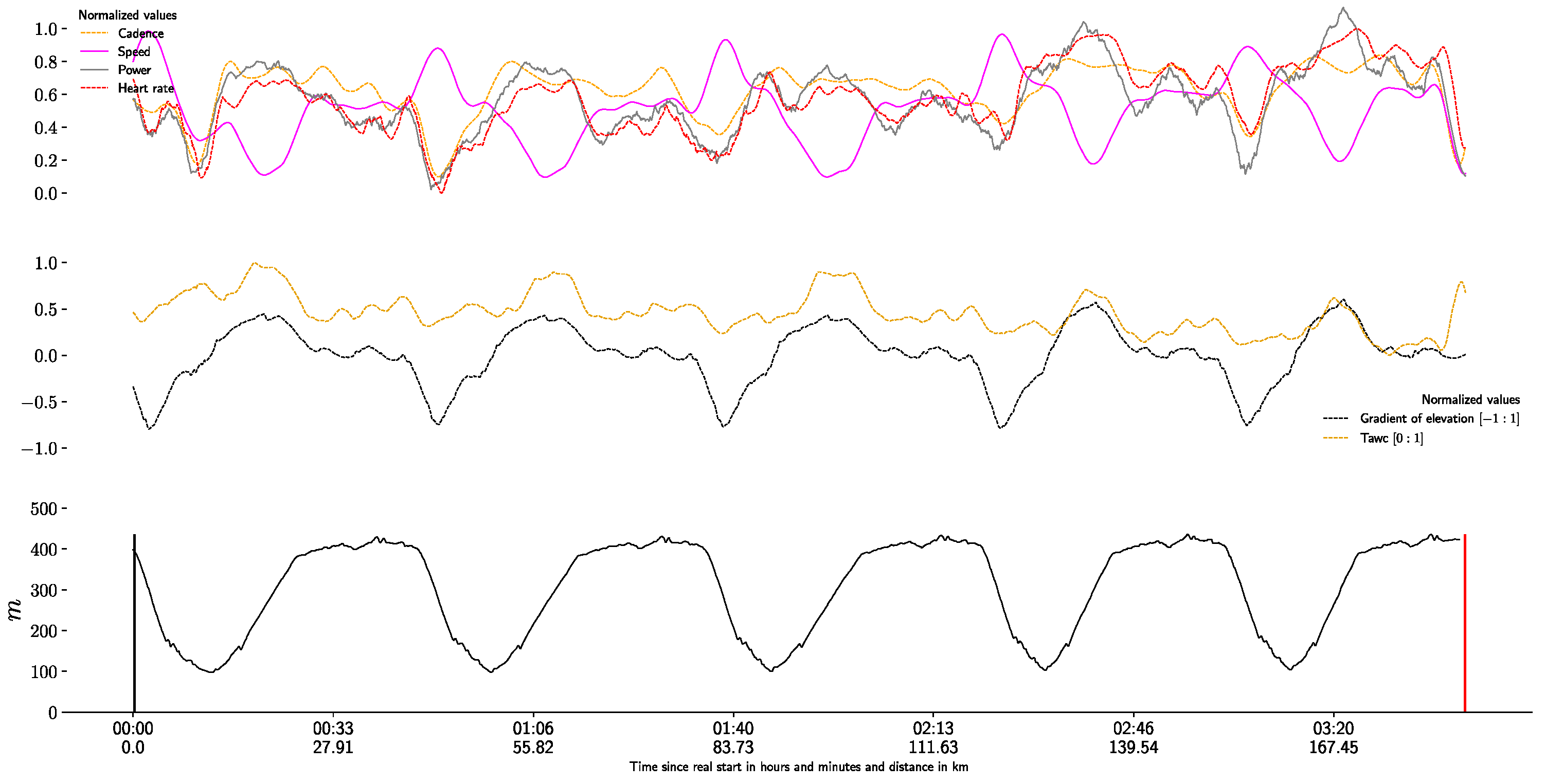
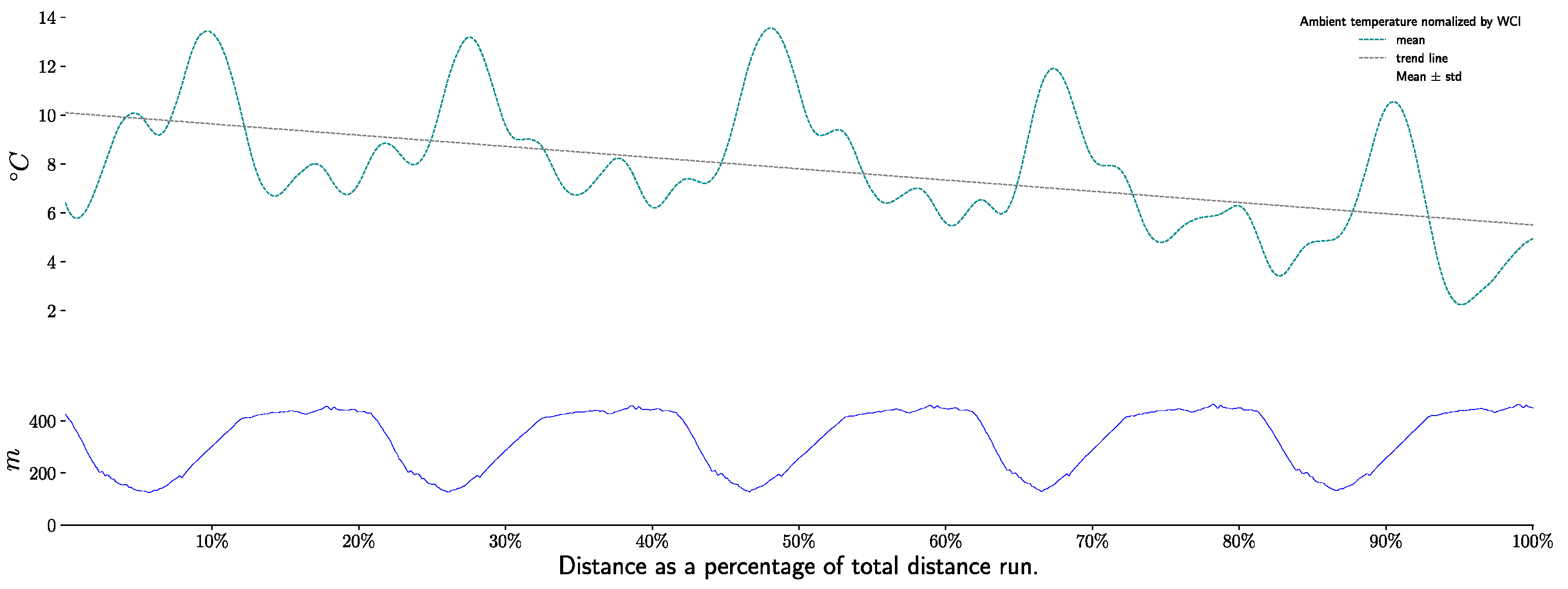
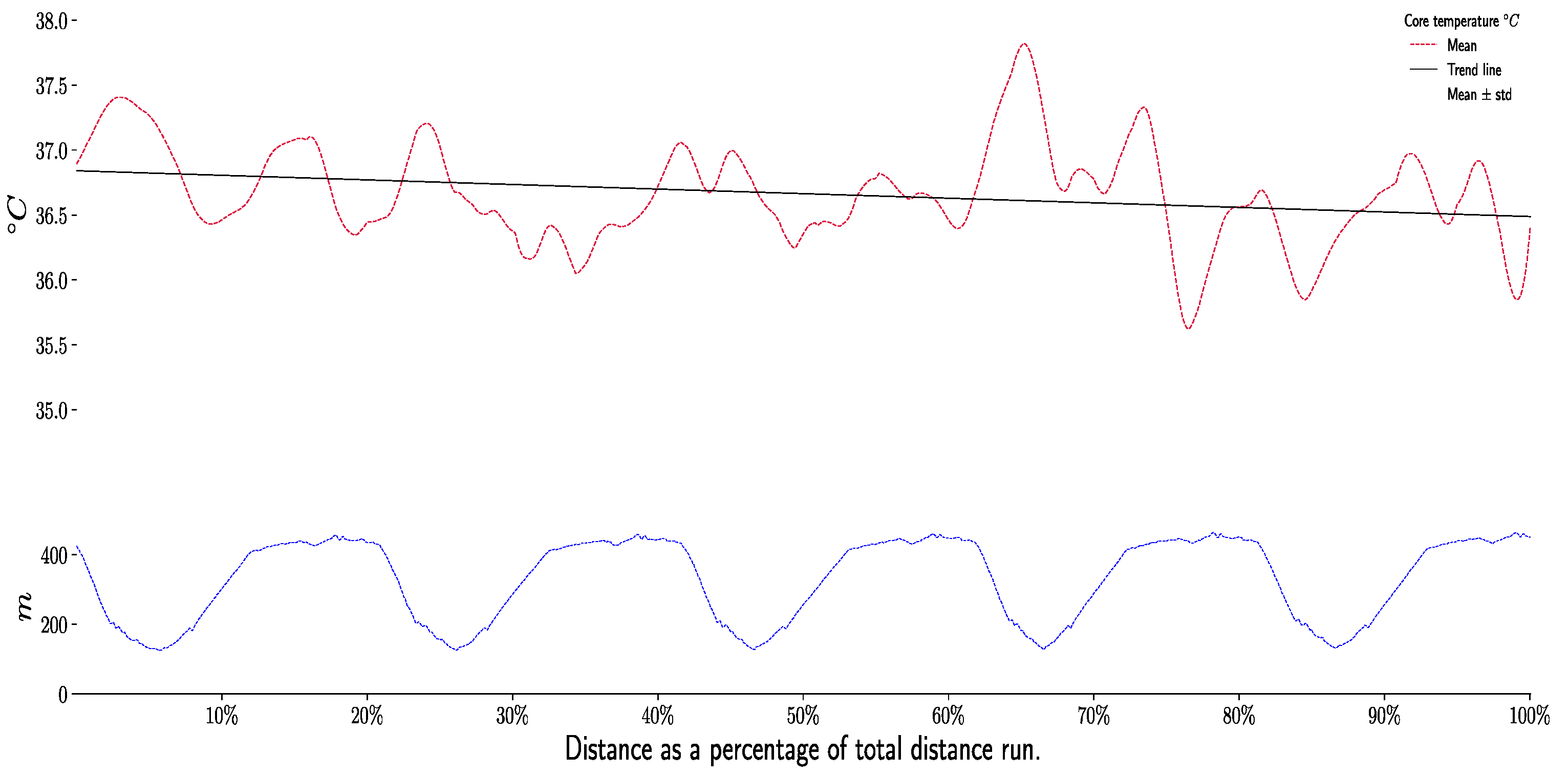
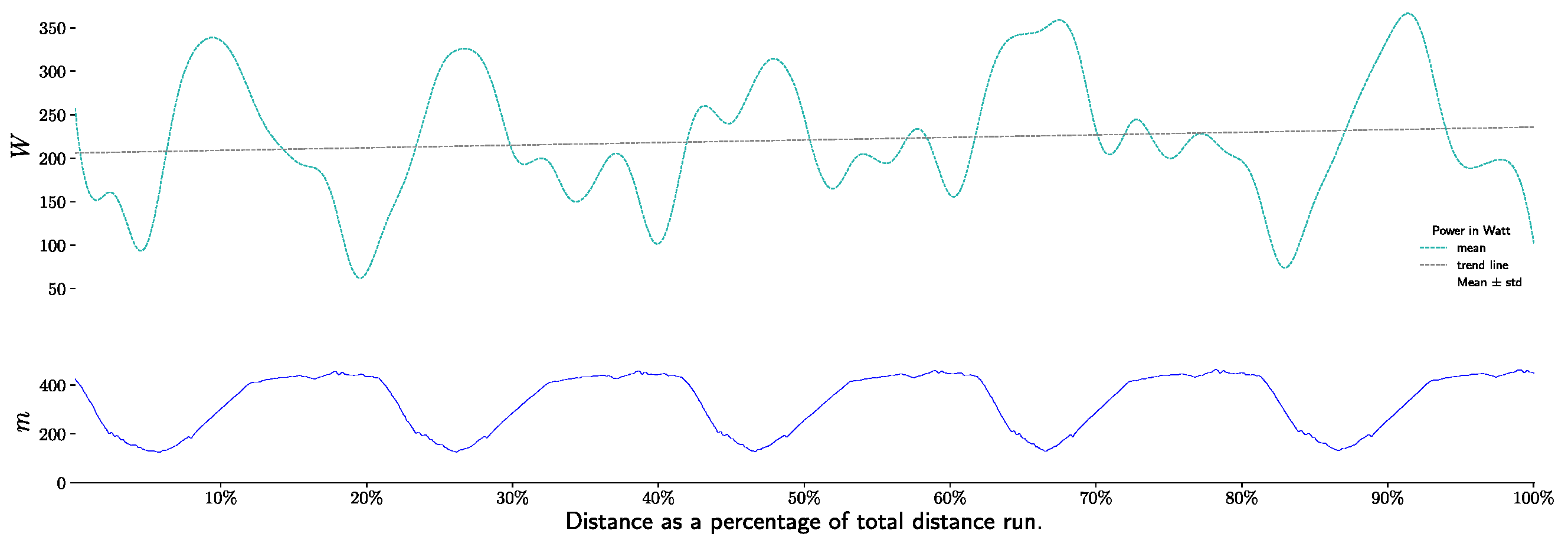
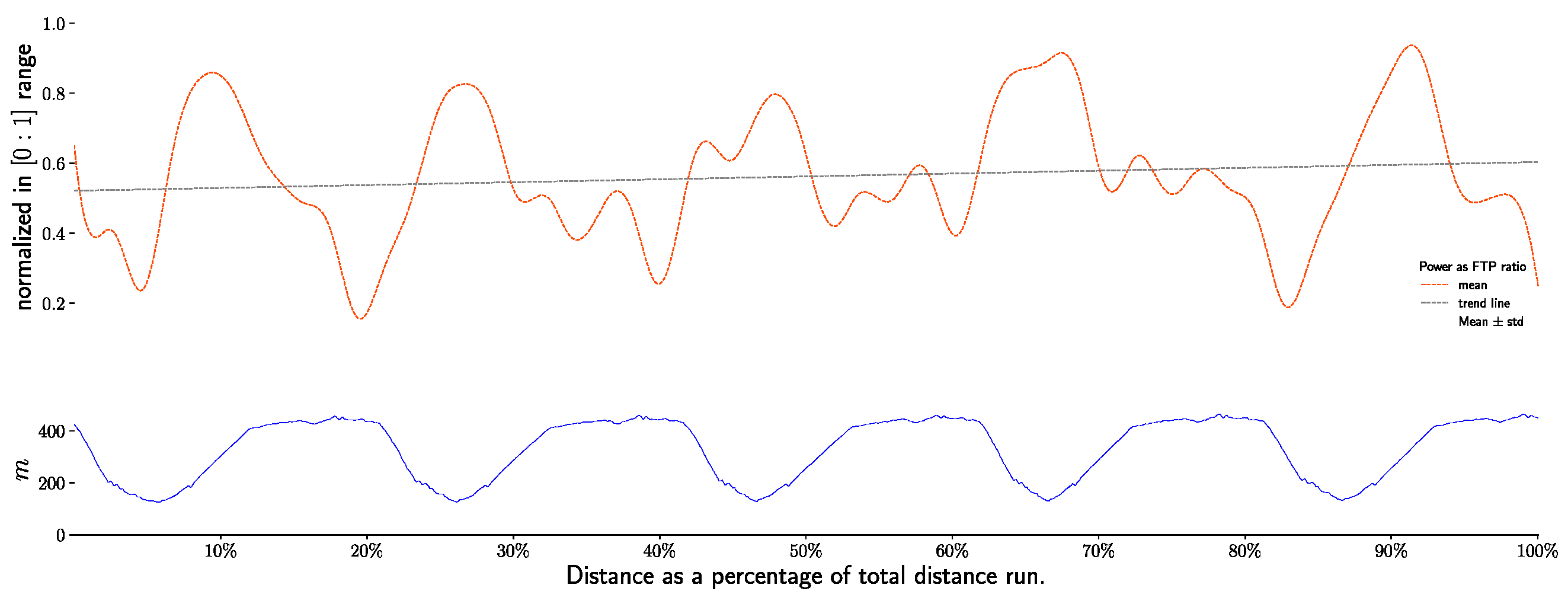
| Section | Distance | Elevation Gain | Mean Elevation | Maximal Elevation |
|---|---|---|---|---|
| Stage | 181.00 km | 2315 m | ||
| Track | 29.80 km | 353 m | ||
| main climb | 2.80 km | 226 m | 8% | 15.1% |
| Lap | Section | Time (min) | Temperature (°C) | Wii (°C) | Gradient of Elevation (m·s−1) | Core Temperature (°C) | Heart Rate (Bpm) | Power (W) | Speed (mps) | Cadence |
|---|---|---|---|---|---|---|---|---|---|---|
| 1 | Downhill | 12.55 ± 0.36 | 16.71 ± 0.76 | 8.16 ± 2.7 | −0.4 ± 0.42 | 37.25 ± 0.59 | 127.76 ± 16.02 | 143.63 ± 54.34 | 13.44 ± 4.41 | 53.0 ± 13.34 |
| Uphill | 14.34 ± 0.5 | 16.93 ± 0.66 | 11.41 ± 2.39 | 0.06 ± 0.19 | 36.66 ± 0.72 | 146.45 ± 13.61 | 296.47 ± 55.86 | 6.42 ± 1.94 | 81.14 ± 7.53 | |
| Flat | 13.89 ± 0.36 | 16.24 ± 0.82 | 7.64 ± 1.53 | 0.32 ± 0.23 | 36.97 ± 0.65 | 136.64 ± 10.38 | 206.71 ± 35.81 | 11.16 ± 0.88 | 80.0 ± 6.07 | |
| Lap | 40.78 ± 0.41 | 16.63 ± 0.8 | 9.11 ± 2.81 | 0.01 ± 0.32 | 36.95 ± 0.7 | 137.28 ± 15.43 | 218.23 ± 79.54 | 10.23 ± 4.01 | 72.03 ± 15.82 | |
| 2 | Downhill | 12.47 ± 0.31 | 149.90 ± 8.32 | 7.72 ± 1.34 | −0.41 ± 0.38 | 36.43 ± 1.0 | 112.97 ± 10.26 | 111.9 ± 50.71 | 13.91 ± 2.37 | 46.92 ± 16.15 |
| Uphill | 14.24 ± 0.31 | 16.43 ± 0.55 | 10.94 ± 2.28 | 0.02 ± 0.21 | 36.50 ± 1.87 | 148.37 ± 9.47 | 295.51 ± 41.93 | 6.29 ± 2.32 | 83.09 ± 5.64 | |
| Flat | 20.78 ± 0.08 | 16.42 ± 0.86 | 8.01 ± 1.5 | 0.33 ± 0.22 | 35.82 ± 1.98 | 130.79 ± 8.95 | 184.43 ± 32.84 | 10.98 ± 1.06 | 73.99 ± 7.09 | |
| Lap | 47.49 ± 0.21 | 16.52 ± 0.72 | 8.80 ± 2.22 | 0.01 ± 0.32 | 36.18 ± 1.76 | 131.26 ± 16.29 | 198.05 ± 80.89 | 10.37 ± 3.47 | 69.49 ± 17.32 | |
| 3 | Downhill | 11.88 ± 0.28 | 16.40 ± 0.49 | 6.81 ± 1.13 | −0.43 ± 0.42 | 36.74 ± 1.06 | 130.07 ± 17.05 | 173.08 ± 77.91 | 14.88 ± 2.03 | 60.88 ± 15.89 |
| Uphill | 13.79 ± 1.72 | 16.64 ± 0.8 | 11.32 ± 2.47 | 0.02 ± 0.23 | 36.47 ± 1.37 | 149.90 ± 8.32 | 277.37 ± 42.56 | 6.14 ± 2.29 | 80.55 ± 5.56 | |
| Flat | 20.38 ± 0.08 | 16.41 ± 0.87 | 7.83 ± 1.58 | 0.32 ± 0.21 | 36.54 ± 1.34 | 138.08 ± 10.53 | 201.07 ± 39.62 | 11.27 ± 1.0 | 75.5 ± 9.29 | |
| Lap | 46.05 ± 0.69 | 16.48 ± 0.78 | 8.64 ± 2.58 | 0.01 ± 0.32 | 36.57 ± 1.29 | 139.66 ± 14.18 | 217.3 ± 67.23 | 10.62 ± 3.75 | 73.31 ± 13.03 | |
| 4 | Downhill | 11.23 ± 0.27 | 15.99 ± 0.48 | 5.97 ± 1.13 | −0.45 ± 0.43 | 36.67 ± 1.02 | 149.65 ± 15.07 | 223.52 ± 75.18 | 15.78 ± 2.04 | 66.0 ± 10.5 |
| Uphill | 12.92 ± 1.1 | 15.95 ± 0.46 | 9.80 ± 2.5 | 0.01 ± 0.23 | 37.17 ± 1.34 | 170.33 ± 7.75 | 345.49 ± 24.59 | 7.14 ± 3.05 | 83.62 ± 6.27 | |
| Flat | 26.29 ± 1.18 | 15.38 ± 0.97 | 6.24 ± 1.64 | 0.37 ± 0.24 | 36.09 ± 1.94 | 145.74 ± 12.2 | 213.58 ± 31.8 | 11.48 ± 0.98 | 76.65 ± 8.15 | |
| Lap | 50.44 ± 0.85 | 15.66 ± 0.83 | 7.05 ± 2.39 | 0.01 ± 0.32 | 36.49 ± 1.69 | 152.66 ± 15.77 | 248.19 ± 71.18 | 11.4 ± 3.55 | 75.91 ± 10.36 | |
| 5 | Downhill | 12.63 ± 0.58 | 14.56 ± 0.5 | 4.21 ± 1.09 | −0.4 ± 0.39 | 36.07 ± 1.60 | 124.3 ± 15.39 | 126.1 ± 55.98 | 14.04 ± 2.14 | 54.27 ± 14.11 |
| Uphill | 14.48 ± 1.61 | 14.73 ± 0.44 | 8.34 ± 2.14 | 0.04 ± 0.22 | 36.7 ± 1.11 | 155.25 ± 14.45 | 315.11 ± 46.25 | 6.76 ± 2.32 | 81.49 ± 6.14 | |
| Flat | 16.06 ± 1.08 | 13.28 ± 0.81 | 3.46 ± 2.06 | 0.31 ± 0.21 | 36.40 ± 1.13 | 142.41 ± 18.99 | 199.14 ± 51.84 | 10.92 ± 1.51 | 76.24 ± 11.89 | |
| Lap | 43.17 ± 1.09 | 14.11 ± 0.92 | 5.18 ± 2.82 | 0.01 ± 0.32 | 36.79 ± 1.40 | 140.93 ± 20.58 | 212.83 ± 90.46 | 10.58 ± 3.47 | 71.27 ± 15.97 | |
| Overall Race | 227.93 ± 1.37 | 15.60 ± 1.37 | 7.77 ± 2.04 | 0.01 ± 0.32 | 36.58 ± 1.46 | 140.54 ± 18.03 | 219.33 ± 79.72 | 10.66 ± 3.67 | 72.47 ± 14.79 | |
| TAWC | Power | Power as FTP | Speed | Cadence | Heart Rate | Core Temperature |
|---|---|---|---|---|---|---|
| Downhill | 0.04 *** | 0.04 *** | −0.56 ** | −0.02 ** | −0.05 *** | 0.31 ** |
| Uphill | 0.30 *** | 0.28 ** | −0.84 ** | −0.43 ** | 0.18 ** | −0.11 ** |
| Flat | 0.04 ** | −0.03 *** | 0.43 ** | −0.19 ** | −0.11 ** | −0.07 *** |
| Power as Ratio of FTP Test | Speed | Cadence | Heart Rate | Core Temperature | Gradient of Elevation |
|---|---|---|---|---|---|
| Downhill | −0.42 ** | 0.13 *** | 0.66 ** | 0.020 ** | 0.67 ** |
| Uphill | −0.10 ** | 0.89 ** | 0.87 ** | 0.080 *** | 0.43 *** |
| Flat | 0.029 ** | 0.65 ** | 0.69 *** | 0.12 | 0.43 ** |
Publisher’s Note: MDPI stays neutral with regard to jurisdictional claims in published maps and institutional affiliations. |
© 2021 by the authors. Licensee MDPI, Basel, Switzerland. This article is an open access article distributed under the terms and conditions of the Creative Commons Attribution (CC BY) license (https://creativecommons.org/licenses/by/4.0/).
Share and Cite
Riera, F.; Bellenoue, S.; Fischer, S.; Méric, H. Impact of a Cold Environment on the Performance of Professional Cyclists: A Pilot Study. Life 2021, 11, 1326. https://doi.org/10.3390/life11121326
Riera F, Bellenoue S, Fischer S, Méric H. Impact of a Cold Environment on the Performance of Professional Cyclists: A Pilot Study. Life. 2021; 11(12):1326. https://doi.org/10.3390/life11121326
Chicago/Turabian StyleRiera, Florence, Samuel Bellenoue, Simon Fischer, and Henri Méric. 2021. "Impact of a Cold Environment on the Performance of Professional Cyclists: A Pilot Study" Life 11, no. 12: 1326. https://doi.org/10.3390/life11121326
APA StyleRiera, F., Bellenoue, S., Fischer, S., & Méric, H. (2021). Impact of a Cold Environment on the Performance of Professional Cyclists: A Pilot Study. Life, 11(12), 1326. https://doi.org/10.3390/life11121326






